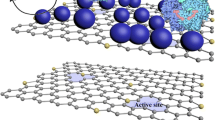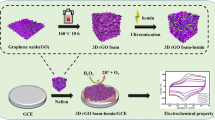Abstract
The authors describe a chemical sensor for dopamine (DA). It is based on the use of three-dimensional graphene oxide (3D rGO) loaded with varying amounts of AuPd bimetallic nanoparticles (3D rGO/AuPd NPs). The 3D rGO acts as an effective substrate providing a large surface area and allowing fast electron transfer. The interaction between 3D rGO and surface AuPd NPs increases the activity of the sensing material. These composites were fabricated as the active layer on an indium tin oxide for DA determination. The electrode showed the best performance at a working potential of 0.25 V (vs. the saturated calomel reference electrode) and a scan rate of 100 mVs−1. The best electrode exhibits good sensitivity (4670 μA·mM−1·cm−2), a wide linear response (0.5 μM to 135 μM), and a low detection limit (0.2 μM). It is also selective, easily reproducible, and stable. It was applied to the determination of DA in spiked human serum and in clinical DA hydrochloride injections. The excellent performance of this electrode is attributed to the efficient electron transfer and large specific surface area of 3D rGO and to the high electrocatalytic activity of AuPd NPs due to the synergistic effect between the 3D rGO substrate and the AuPd alloy NPs.

An three-dimensional reduced graphene oxide (3D rGO) foam was loaded with AuPd bimetallic nanoparticles and applied to dopamine (DA) detection in human serum and an injection fluid.






Similar content being viewed by others
References
Wightman MR, May LJ, Michae AC (1988) Detection of dopamine dynamics in the brain. Anal Chem 60:769A–793A
Kim YR, Bong S, Kang YJ, Yang Y, Mahajan RK, Kim JS, Kim H (2010) Electrochemical detection of dopamine in the presence of ascorbic acid using graphene modified electrodes. Biosens Bioelectron 25(10):2366–2369
Zhuang XM, Chen DD, Zhang S, Luan F, Chen LX (2018) Reduced graphene oxide functionalized with a CoS2/ionic liquid composite and decorated with gold nanoparticles for voltammetric sensing of dopamine. Microchim Acta 185(3):166
Liu JC, Xie YZ, Wang K, Zeng QT, Liu R, Liu XY (2017) A nanocomposite consisting of carbon nanotubes and gold nanoparticles in an amphiphilic copolymer for voltammetric determination of dopamine, paracetamol and uric acid. Microchim Acta 184(6):1739–1745
Thearle RA, Latiff NM, Sofer Z, Mazanek V, Pumera M (2017) Boron and nitrogen doped graphene via microwave exfoliation for simultaneous electrochemical detection of ascorbic acid, dopamine and uric acid. Electroanal 29(1):45–50
Robinson DL, Hermans A, Seipel AT, Wightman RM (2008) Monitoring rapid chemical communication in the brain. Chem Rev 108(7):2554–2584
Pruneanu S, Biris AR, Pogacean F, Socaci C, Coros M, Rosu MC, Watanabe F, Biris AS (2015) The influence of uric and ascorbic acid on the electrochemical detection of dopamine using graphene-modified electrodes. Electrochim Acta 154:197–204
Zhang X, Zhang YC, Ma LX (2016) One-pot facile fabrication of graphene-zinc oxide composite and its enhanced sensitivity for simultaneous electrochemical detection of ascorbic acid, dopamine and uric acid. Sensor Actuat B-Chem 227:488–496
Liu HL, Nosheen F, Wang X (2015) Noble metal alloy complex nanostructures: controllable synthesis and their electrochemical property. Chem Soc Rev 44(10):3056–3078
Xu Y, Zhang B (2014) Recent advances in porous Pt-based nanostructures: synthesis and electrochemical applications. Chem Soc Rev 43(8):2439–2450
Hsu SC, Chuang YC, Sneed BT, Cullen DA, Chiu TW, Kuo CH (2016) Turning the halide switch in the synthesis of au-Pd alloy and core-shell nanoicosahedra with terraced shells: performance in electrochemical and plasmon-enhanced catalysis. Nano Lett 16(9):5514–5520
Zhang S, Shao YY, Liao HG, Liu J, Aksay IA, Yin GP, Lin YH (2011) Graphene decorated with PtAu alloy nanoparticles: facile synthesis and promising application for formic acid oxidation. Chem Mater 23(5):1079–1081
Dong WH, Ren YP, Bai ZX, Jiao J, Chen Y, Han BK, Chen Q (2018) Synthesis of tetrahexahedral au-Pd core-shell nanocrystals and reduction of graphene oxide for the electrochemical detection of epinephrine. J Colloid Interf Sci 512:812–818
Dutta S, Ray C, Mallick S, Sarkar S, Roy A, Pal T (2015) Au@Pd core-shell nanoparticles-decorated reduced graphene oxide: a highly sensitive and selective platform for electrochemical detection of hydrazine. RSC Adv 5(64):51690–51700
Jiang JJ, Du XZ (2014) Sensitive electrochemical sensors for simultaneous determination of ascorbic acid, dopamine, and uric acid based on au@Pd-reduced graphene oxide nanocomposites. Nanoscale 6(19):11303–11309
Tadayon F, Vahed S, Bagheri H (2016) Au-Pd/reduced graphene oxide composite as a new sensing layer for electrochemical determination of ascorbic acid, acetaminophen and tyrosine. Mat Sci Eng C-Mater 68:805–813
Zou CE, Zhong JT, Li S, Wang HW, Wang J, Yan B, Du YK (2017) Fabrication of reduced graphene oxide-bimetallic PdAu nanocomposites for the electrochemical determination of ascorbic acid, dopamine, uric acid and rutin. J Electroanal Chem 805:110–119
Gao HC, Duan HW (2015) 2D and 3D graphene materials: preparation and bioelectrochemical applications. Biosens Bioelectron 65:404–419
Jiang X, Ma YW, Li JJ, Fan QL, Huang W (2010) Self-assembly of reduced graphene oxide into three-dimensional architecture by divalent ion linkage. J Phys Chem C 114(51):22462–22465
Lee SH, Kim HW, Hwang JO, Lee WJ, Kwon J, Bielawski CW, Ruoff RS, Kim SO (2010) Three-dimensional self-assembly of graphene oxide platelets into mechanically flexible macroporous carbon films. Angew Chem Int Edit 49(52):10084–10088
Yin SY, Wu YL, Hu BH, Wang Y, Cai PQ, Tan CK, Qi DP, Zheng LY, Leow WR, Tan NS, Wang ST, Chen XD (2014) Three-dimensional graphene composite macroscopic structures for capture of cancer cells. Adv Mater Interfaces 1(1):1300043
Yin SY, Zhang YY, Kong JH, Zou CJ, Li CM, Lu XH, Ma J, Boey FYC, Chen XD (2011) Assembly of graphene sheets into hierarchical structures for high-performance energy storage. ACS Nano 5(5):3831–3838
Ouyang LK, Da GJ, Tian PF, Chen TY, Liang GD, Xu J, Han YF (2014) Insight into active sites of Pd-au/TiO2 catalysts in hydrogen peroxide synthesis directly from H2 and O2. J Catal 311:129–136
Yan W, He F, Gai SL, Gao P, Chen YJ, Yang PP (2014) A novel 3D structured reduced graphene oxide/TiO2 composite: synthesis and photocatalytic performance. J Mater Chem A 2(10):3605–3612
Zhang H, Xie AJ, Wang CP, Wang HS, Shen YH, Tian XY (2013) Novel rGO/alpha-Fe2O3 composite hydrogel: synthesis, characterization and high performance of electromagnetic wave absorption. J Mater Chem A 1(30):8547–8552
Dong XC, Wang XW, Wang LH, Song H, Zhang H, Huang W, Chen P (2012) 3D graphene foam as a monolithic and macroporous carbon electrode for electrochemical sensing. Acs Appl Mater Inter 4(6):3129–3133
Acknowledgements
This work was supported by the National Key Research and Development Program (No. 2016YFC0207101), the Major State Basic Research Development Program of China (973 Program) (No. 2014CB643506), the Jilin Province Science Foundation of China (No. 20180101210JC, 20170520129JH), and the National Natural Science Foundation of China (Grant No. 61775080, 11674126, 11674127).
Author information
Authors and Affiliations
Corresponding authors
Ethics declarations
The author(s) declare that they have no competing interests.
Electronic supplementary material
ESM 1
(DOCX 1.95 mb)
Rights and permissions
About this article
Cite this article
Hou, Y., Sheng, K., Lu, Y. et al. Three-dimensional graphene oxide foams loaded with AuPd alloy: a sensitive electrochemical sensor for dopamine. Microchim Acta 185, 397 (2018). https://doi.org/10.1007/s00604-018-2925-0
Received:
Accepted:
Published:
DOI: https://doi.org/10.1007/s00604-018-2925-0




